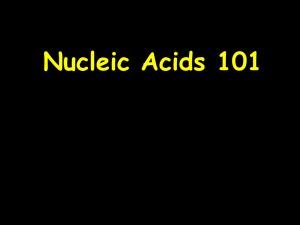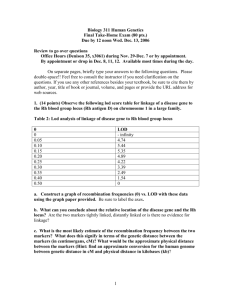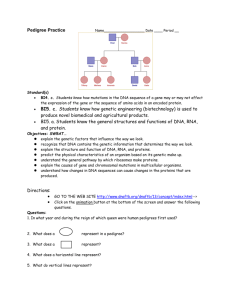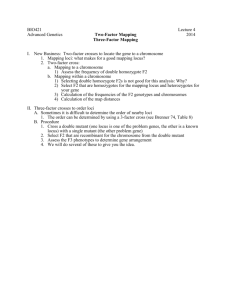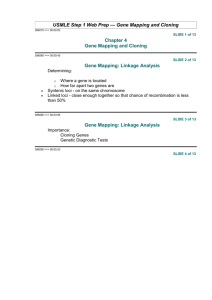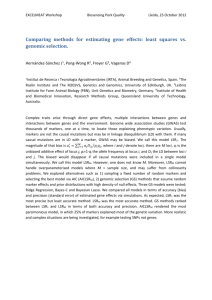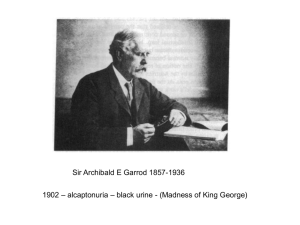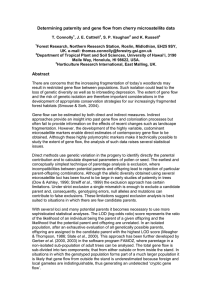Biology 311
advertisement
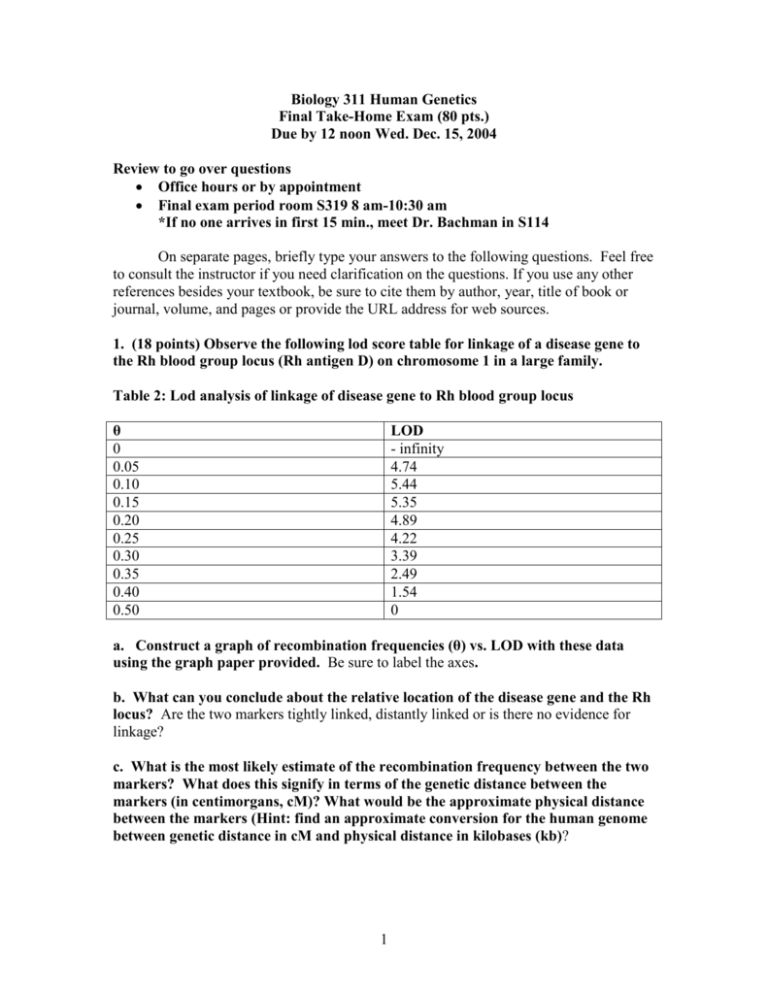
Biology 311 Human Genetics Final Take-Home Exam (80 pts.) Due by 12 noon Wed. Dec. 15, 2004 Review to go over questions Office hours or by appointment Final exam period room S319 8 am-10:30 am *If no one arrives in first 15 min., meet Dr. Bachman in S114 On separate pages, briefly type your answers to the following questions. Feel free to consult the instructor if you need clarification on the questions. If you use any other references besides your textbook, be sure to cite them by author, year, title of book or journal, volume, and pages or provide the URL address for web sources. 1. (18 points) Observe the following lod score table for linkage of a disease gene to the Rh blood group locus (Rh antigen D) on chromosome 1 in a large family. Table 2: Lod analysis of linkage of disease gene to Rh blood group locus θ 0 0.05 0.10 0.15 0.20 0.25 0.30 0.35 0.40 0.50 LOD - infinity 4.74 5.44 5.35 4.89 4.22 3.39 2.49 1.54 0 a. Construct a graph of recombination frequencies (θ) vs. LOD with these data using the graph paper provided. Be sure to label the axes. b. What can you conclude about the relative location of the disease gene and the Rh locus? Are the two markers tightly linked, distantly linked or is there no evidence for linkage? c. What is the most likely estimate of the recombination frequency between the two markers? What does this signify in terms of the genetic distance between the markers (in centimorgans, cM)? What would be the approximate physical distance between the markers (Hint: find an approximate conversion for the human genome between genetic distance in cM and physical distance in kilobases (kb)? 1 2. (10 points) The gene for the autosomal dominant disease shown in this pedigree is thought to be on chromosome 4, so five RFLPs (1-5) mapped on chromosome 4 were tested in all family members. The results of the testing are shown below each individual listed in the pedigree. Vertical lines represent the two homologous chromosomes and the superscripts represent different alleles of the RFLP loci. 1◦ 2◦ 3' 4◦ 5' 1◦ 2◦ 3' 4◦ 5◦ 1◦ 2' 3◦ 4' 5◦ 1' 2◦ 3◦ 4' 5◦ 1◦ 2◦ 3' 4' 5◦ 1◦ 1◦ 2" 2' 3◦ 3" 4' 4" 5◦ 5◦ 1◦ 2" 3◦ 4' 5◦ 1' 1◦ 2◦ 2' 3' 3' 4' 4' 5◦ 5◦ 1' 2◦ 3' 4◦ 5' 1◦ 2" 3◦ 4' 5◦ a. Explain the procedures that would be used to get the RFLP test results, using RFLP1, for example. b. Decide which RFLP locus is closest to the disease gene (explain your logic). c. Suggest a possible strategy you could use to isolate the disease gene. Include a brief description of each of the significant methods you would use and how they would help you locate and isolate the gene. 3. (8 points) Briefly summarize in about a paragraph one of the class presentations other than your own. Include in your summary what the presentation was about how the presentation related to human genetics new information you learned from the presentation 2 4. (14 pts) Go to the University of Arizona Biology Project website and familiarize yourself with the Blackett Family DNA Activity. Answer the following questions. http://www.biology.Arizona.edu/human_bio/activities/blackett2/ a. What are the CODIS STR loci? Explain their application in human genetic analysis. b. Complete the enclosed pedigree sheet with the genotypes of all the Blackett family members for the three STR loci provided (D3S1358, vWA and FGA). Deduce the possible genotype of Steve. 5. (20 pts) Distinguish between any 5 of the following 10 terms or phrases. a. transgenic mouse and knock-out mouse b. slipped mispairing and unequal crossover c. SINE elements and LINE elements d. somatic cell hybrid panels and radiation hybrid panels e. position-independent cloning and positional cloning f. autozygosity mapping and linkage disequilibrium g. loss of function mutations and gain of function mutations h. retroviral vectors and adenoviral vectors for gene therapy i. SSCP analysis and protein truncation test j. DNA fingerprinting with minisatellite probes and DNA profiling with microsatellite markers 6. (10 points) A genetic counselor has the following DNA testing results. For each case study, describe how the test might be performed. determine what advice the counselor can offer in the way of disease risk or possible treatment for the given outcome. a. A DNA test for APOE (Apolipoprotein E) indicates the patient is homozygous for the E4 allele. b. A DNA test for Huntingtin's disease (HD) indicates the patient has one allele with about 50 triplet repeats and one allele with about 20 triplet repeats. 3
